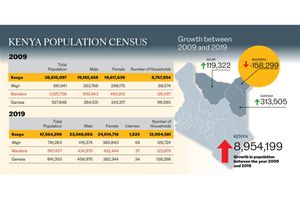Happening now: Mlolongo Three: IG Kanja, DCI boss Amin expected in court
Building a farmer’s dairy cattle herd

A woman admires a Jersey cow. The quickest way to buy high-quality pregnant animals is between six months of pregnancy and the first three months after calving.
What you need to know:
- A farmer can select genetically good animals in poor body condition, rehabilitate them and breed them with the desired semen though this option takes time.
Practising, potential and aspiring farmers keep asking the best way of establishing a good dairy herd.
My answer has always been that there is no best way of establishing your desired herd.
The reason for this response is that many variables influence the route a farmer takes to establish a dairy herd.
Dairy farming is not and should not be a hobby or an idle pastime.
Dairying should be a business that serves to build wealth, satisfaction, peace of mind and create employment.
Most of all, it contributes to food safety and security at the local, national and global level.
Most people never even factor in dairy production when they discuss the millions of children born and brought up in Kenya every year, with milk as a major component of their diet.
Further, dairying is a business that utilises biological assets as the key input of the operation.
The assets, as starter stock, attract different purchase prices, depending on the level of production at which they are acquired.
Therefore, the option one takes to arrive at the best way of establishing their dairy herd depends on the farmer’s initial cash investment in cattle and how quickly he or she intends to start milk production.
It also depends on the quality of animals one plans to stock and the level of production per cow.
In some countries, it may be important to consider the quality of milk in form of butterfat content.
The butterfat content is important in nations cheese is made in plenty or higher butterfat content fetches better milk prices.
Milk for sale is not scored for the butter fat content in Kenya.
Vulnerable to illnesses
My advice to farmers on what stocks to keep always starts with two aspects.
If one is keeping animals only for milk production, then they can keep cattle that are not necessarily pure but those that will be best suited to produce a targeted quantity per animal per day with minimum feed input.
For instance, the Sahiwal-Zebu cross does very well in arid and semi-arid areas where feed is low quality and scarce.
Farmers who keep cattle for milk production and sale of breeding stock should keep high-producing pure breeds or pedigrees.
Pure breeds are animals with breeding and production records properly kept by the farmer.
The animals must also be judged as pure by an expert, based on the visible characteristics of coat colour, body form and milk yield.
Pedigree animals are similar to pure ones. However, the animals and their records are inspected and registered by the official cattle breeds standards organisation in the country.
In Kenya, pedigree breeds are authenticated and registered by the Kenya Stud Book under the Kenya Livestock Breeders Association (KLBA).
There are several options for a farmer to establish a great dairy herd.
The quickest way is to buy high quality pregnant animals between six months of pregnancy and the first three months after calving.
This option is very costly because animals attract the premium price for the breed.
Second, animals in the first three months of lactation are vulnerable to diseases such as mastitis, milk fever and ketosis.
It is, therefore, advisable to buy animals that are in the last three months of pregnancy rather than the peak of lactation if one is not concerned with the high price of animals.
Generally, cattle more than three months pregnant will sell at the same price as breeders argue the animals are already confirmed pregnant.
It is, therefore, always better for one to buy animals from five months pregnant instead of buying those between three and five months; unless the seller would be willing to lower the price significantly for the younger pregnancies.
In most cases, the price of a bulling heifer, meaning one that is ready for breeding, doubles as soon as the animal is inseminated with pure-breed semen.
I, therefore, advise farmers to buy their heifers empty and inseminate for themselves in order to save on cost.
There is also the option of buying growing heifers and maturing them for breeding on your farm.
Economists discourage this option, based on the long time it takes to feed animals that are not productive.
But farmers with cash constraints choose the option, arguing that they spend money in small amounts over time.
It is, therefore, consideration for affordability of the option rather than the one that makes the most economic sense.
Another option is the use of pure and pedigree sexed embryos to produce pure and pedigree dairy cattle from cattle of any breed.
The cow is inseminated with a fertilised egg pre-determined to be a heifer embryo.
The mother cow only serves to carry the pregnancy to term and contributes no genetic material to the calf.
This option is expensive and takes a long time to establish the herd due to the low conception rate of about 35 per cent.
Finally, a farmer can select genetically good animals in poor body condition, rehabilitate them and breed them with the desired semen.
This option takes time but also produces good results.
Last week, I had a farmer who wished to set up an Ayrshire pedigree dairy herd but could not afford pregnant heifers at Sh200,000 each.
I advised her to buy bulling heifers at Sh80,000 each and inseminate them when they come on heat.





